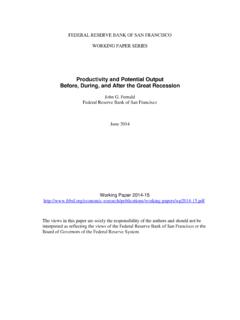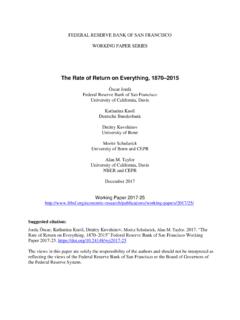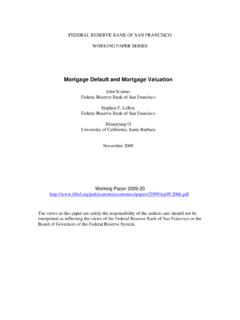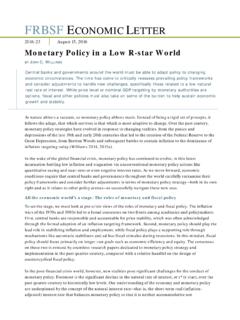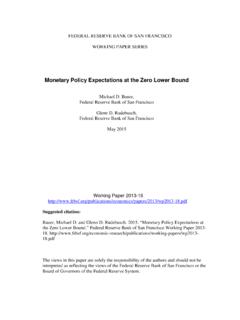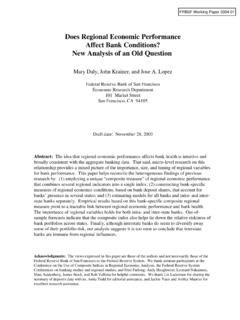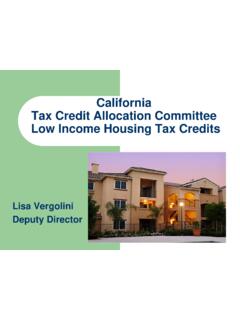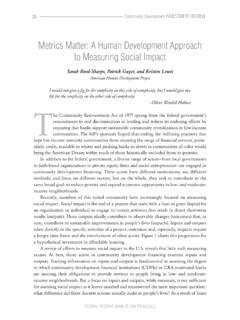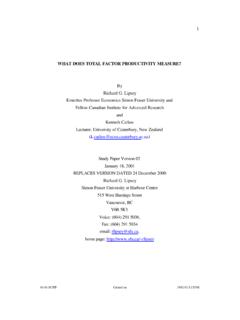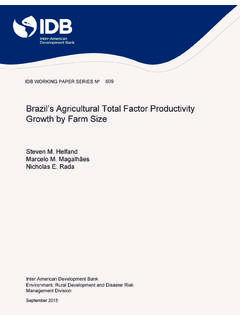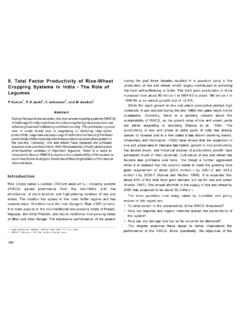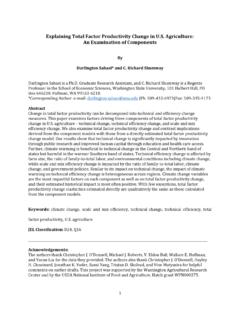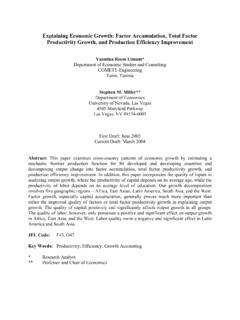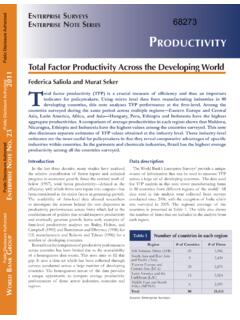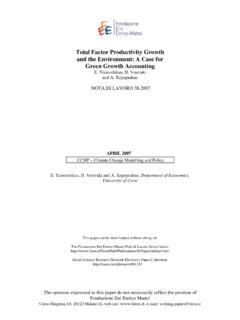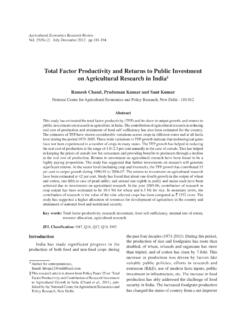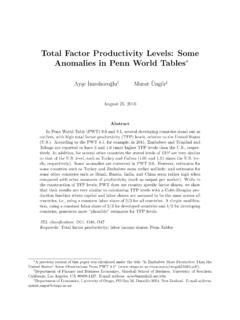Transcription of A Quarterly, Utilization-Adjusted Series on Total Factor ...
1 FEDERAL RESERVE BANK OF SAN FRANCISCO WORKING PAPER Series a quarterly , Utilization-Adjusted Series on Total Factor productivity John Fernald Federal Reserve Bank of San Francisco April 2014 John Fernald. 2014. a quarterly , Utilization-Adjusted Series on Total Factor productivity Federal Reserve Bank of San Francisco Working Paper 2012-19. The views in this paper are solely the responsibility of the author and should not be interpreted as reflecting the views of the Federal Reserve Bank of San Francisco or the Board of Governors of the Federal Reserve System. Working Paper 2012-19 a quarterly , Utilization-Adjusted Series on Total Factor productivity John Fernald* Federal Reserve Bank of San Francisco April 2014 , Abstract: This paper describes a real-time, quarterly growth-accounting database for the business sector.
2 The data on inputs, including capital, are used to produce a quarterly Series on Total Factor productivity (TFP). In addition, the dataset implements an adjustment for variations in Factor utilization labor effort and the workweek of capital. The utilization adjustment follows Basu, Fernald, and Kimball (BFK, 2006) as updated in Basu, Fernald, Fisher, and Kimball (BFFK, 2013). Using relative prices and input-output information, the Series are also decomposed into separate TFP and Utilization-Adjusted TFP Series for equipment investment (including consumer durables) and consumption (defined as business output less equipment and consumer durables). JEL Codes: E22, E23, O41, O47, Keywords: Total Factor productivity , cyclical productivity , multi-sector growth models * Contact email: The data described in this paper are available at I thank several excellent research assistants who have worked with me on this project, most notably Kyle Matoba (who wrote and rewrote large portions of the code and found sensible solutions to a range of practical problems), as well as Titan Alon, Kuni Natsuki, and David Thipphavong.
3 This draft is updated intermittently as I make improvements in methodology. For helpful discussions of various aspects of the implementation, I especially thank Susanto Basu, Ryan Forshay, Bob Hall, and Bart Hobijn. In addition, I thank other colleagues at the San Francisco Fed as well as seminar participants where related papers were presented for providing helpful comments on the dataset. The views in this paper are solely the responsibility of the authors and should not be interpreted as reflecting the views of the Federal Reserve Bank of San Francisco or the Board of Governors of the Federal Reserve System. Academic researchers and policymakers frequently want high-frequency measures of technology. These measures might be fed into models, or used to understand the effects of technology shocks on the economy, or to assess trends in potential output.
4 Relatively crude measures of the Solow residual are easy to construct. But more careful quarterly measures that better correspond to theoretical concepts are more difficult to construct. With annual data, in contrast, there are several relatively high-quality sources of aggregate and/or industry Total Factor productivity (TFP), including the multifactor productivity measures produced by the Bureau of Labor Statistics (BLS), various measures produced by Dale Jorgenson and collaborators,1 and the EU KLEMS project. This paper describes a new real-time, quarterly growth-accounting database for the business sector. There are three major advantages relative to na ve or crude Solow residuals. First, the data on inputs, including both capital and labor, apply the careful growth-accounting methods used by the BLS, Jorgenson, EU-KLEMS, and others.
5 Second, the quarterly dataset implements an adjustment for variations in Factor utilization that follows Basu, Fernald, and Kimball (BFK, 2006). (As of March 2014, the estimates have been updated using Basu, Fernald, Fisher, and Kimball (2014), which is the same model and method, but more recent data.) After all, even the most careful measure of raw TFP does not provide a quarterly measure of technology change. A major reason is variations in Factor utilization labor effort and the workweek of capital. Third, using relative prices and input-output information, the Series are also decomposed into separate TFP and Utilization-Adjusted TFP Series for equipment investment (including 1 For references and available datasets, see (accessed September 26, 2012).)
6 2 consumer durables) and consumption (defined as business output less equipment and consumer durables). Because of the utilization -adjustment, the resulting relative technology Series are not simply equated to relative prices (the default in much of the macro literature that follows Greenwood, Hercowitz, and Krusell, 1997). In terms of the first advantage, careful growth accounting controls for heterogeneity across workers and types of capital. Consider labor input. Simple hours worked data ( , from the BLS productivity and cost release) combine hours of construction workers, fast-food cashiers, auto mechanics, dentists, engineers, CEOs, and so forth. These workers have very different wage rates which, presumably, correspond to differences in marginal products.
7 Similarly, a computer (which provides a service flow for only three or four years) needs to have a higher marginal product than an office building (which might provide services for 50 years). The dataset weights different inputs using actual or estimated relative Factor prices to control for these differences in implied marginal products. Note that this heterogeneity in the data might matter even for researchers with interest in aggregate models with a representative agent and a single type of capital. For example, labor composition (or quality) fluctuates a fair amount at high frequency , in recessions, labor quality systematically rises, since workers with lower skills and education are more likely to lose their jobs. Unless measured TFP controls for labor composition then, relative to underlying technology, measured TFP will be biased up in recessions.
8 Economic theory suggests that another form of heterogeneity is potentially important: Heterogeneity by type of final product. Considerable recent literature has focused on so-called investment-specific technical change (see, for example, Greenwood, Hercowitz, and Krusell, 1997; and Basu, Fernald, Fisher, and Kimball, BFFK, 2013). I use relative prices to decompose 3 TFP for the aggregate economy into TFP for equipment and consumer durables, and into TFP for consumption (everything other than equipment and consumer durables). As with the standard TFP residual, these measures are not necessarily good measures of technological change from quarter to quarter. Indeed, an important caveat is that Fisher (2006) and BFFK find that pass-through from (fully corrected) relative technology shocks to relative prices is very slow.
9 However, BFFK find that uncorrected measures of relative TFP are more closely related to relative prices almost as a measure of Importantly, the utilization adjustment corrects for a quantitatively important wedge between measured relative TFP and underlying relative technology. The adjustment for variable utilization in the quarterly Series follows Basu, Fernald, Fisher, and Kimball (BFFK, 2013). (Previous versions of this quarterly Series followed Basu, Fernald, and Kimball, BFK, 2006). BFFK and BFK sought to adjust for a range of non-technological factors that affect measured TFP, of which variations in the utilization margin , the intensity margin for the workweek of capital and labor effort are only one. Other potential corrections include allowing for deviations from perfect competition and for various reallocation effects.
10 BFFK update the earlier BFK results, and estimate utilization imposing constant returns, which is more consistent with the current paper (though that turns out not to be a major issue for utilization ). These estimates rely on annual data, where there are rich industry-level details on output and intermediate-input flows, as well as on industry investment. These data are not available quarterly . Nevertheless, the Utilization-Adjusted quarterly Series is an improvement over more na ve measures of TFP as a high-frequency indicator of technological change. 2 The intuition comes from the dual approach to growth accounting: TFP can equivalently be defined as growth in real Factor prices.
